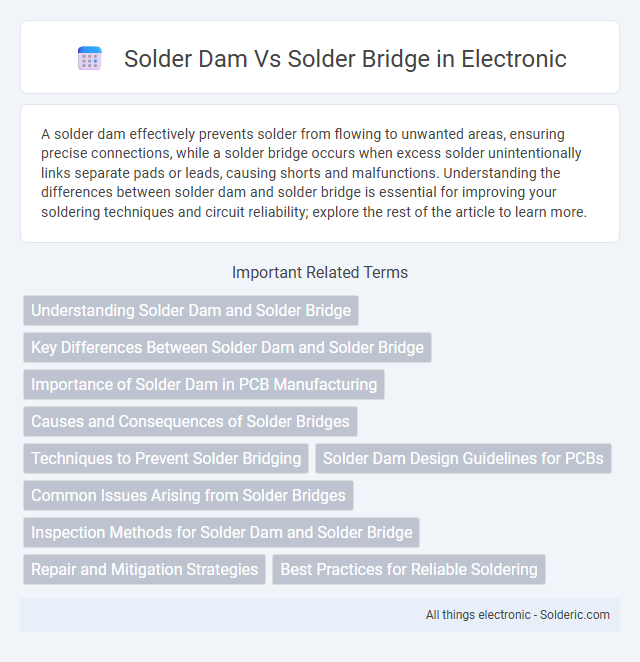A solder dam effectively prevents solder from flowing to unwanted areas, ensuring precise connections, while a solder bridge occurs when excess solder unintentionally links separate pads or leads, causing shorts and malfunctions. Understanding the differences between solder dam and solder bridge is essential for improving your soldering techniques and circuit reliability; explore the rest of the article to learn more.
Comparison Table
| Feature | Solder Dam | Solder Bridge |
|---|---|---|
| Definition | A physical barrier or groove designed to prevent solder from flowing beyond a specific area. | An unintended or intentional connection formed by solder between two conductive points. |
| Purpose | To control solder flow and avoid solder bridging during PCB assembly. | Usually a defect causing shorts, but sometimes used for deliberate electrical connections. |
| Application | Used in PCB design to isolate solder areas. | Occurs during soldering process--either accidental or for specific electrical function. |
| Impact on Circuit | Prevents shorts and improves solder joint reliability. | Can cause short circuits or unintended electrical connections. |
| Detection | Designed feature, confirmed by PCB inspection. | Detected by visual inspection or electrical testing as a defect. |
Understanding Solder Dam and Solder Bridge
A solder dam refers to a deliberate barrier created to prevent molten solder from flowing into undesired areas during PCB assembly, ensuring clean and precise joints. In contrast, a solder bridge occurs unintentionally when excess solder connects two adjacent pads or leads, causing potential short circuits and malfunction. Understanding these terms is critical for quality control in electronics manufacturing and avoiding defects in circuit boards.
Key Differences Between Solder Dam and Solder Bridge
A solder dam is a precise barrier designed to prevent solder from flowing into unwanted areas on a PCB, enhancing assembly quality by controlling solder spread. In contrast, a solder bridge is an unintentional connection formed by excess solder, causing electrical shorts between adjacent pads or components. Understanding these key differences helps you ensure reliable circuit performance and avoid costly rework due to soldering defects.
Importance of Solder Dam in PCB Manufacturing
Solder dam plays a critical role in PCB manufacturing by preventing solder bridge formation between closely spaced pads, ensuring reliable electrical connections and avoiding short circuits. The presence of an effective solder dam enhances the accuracy of solder placement during reflow soldering, leading to higher quality assemblies and reduced risk of defects. Understanding the importance of solder dam helps you optimize PCB designs and improve overall production yield.
Causes and Consequences of Solder Bridges
Solder bridges are caused by excess solder depositing between adjacent pads or leads, often due to improper stencil design, excessive solder paste application, or inadequate soldering temperature control. These bridges create unintended electrical connections, leading to short circuits, malfunctioning circuits, or permanent damage to electronic components. Understanding the causes helps you implement precise soldering techniques and quality checks to prevent costly failures in PCB assembly.
Techniques to Prevent Solder Bridging
Solder dam and solder bridge prevention techniques focus on controlling the flow of molten solder during PCB assembly to avoid unintended electrical connections. Applying a solder dam involves placing a non-conductive barrier, such as solder mask or adhesive tape, between closely spaced pads to restrict solder spread, ensuring precise solder joint formation. Your best practices include using proper stencil design, adjusting solder paste volume, and optimizing reflow profiles to minimize the risk of solder bridges while maintaining strong mechanical and electrical connections.
Solder Dam Design Guidelines for PCBs
Solder dam design guidelines for PCBs focus on preventing solder bridges by incorporating physical barriers such as pads or copper traces between adjacent pads to control solder flow during assembly. Your PCB layout should include appropriately sized solder dams to enhance reliability and reduce the risk of short circuits, especially in fine-pitch components. Ensuring correct spacing and dam dimensions aligned with IPC standards optimizes solder joint quality and manufacturing yield.
Common Issues Arising from Solder Bridges
Solder bridges commonly cause short circuits by unintentionally connecting adjacent pads or leads, leading to malfunctioning circuits and potential component damage. These defects often result from excess solder, inadequate solder mask design, or misaligned components during PCB assembly. Detecting and preventing solder bridges is critical for maintaining signal integrity and reliable electronic device performance.
Inspection Methods for Solder Dam and Solder Bridge
Inspection methods for solder dam and solder bridge primarily involve visual inspection, X-ray imaging, and automated optical inspection (AOI) systems to detect defects in solder joint formations. Visual inspection uses magnification tools to identify solder bridges causing short circuits, whereas X-ray imaging helps reveal hidden solder dams that prevent solder flow between pads. AOI systems utilize machine learning algorithms to differentiate between acceptable solder dams and bridges, ensuring robust solder joint reliability in PCB assemblies.
Repair and Mitigation Strategies
Solder dam techniques prevent solder bridging by applying a non-conductive barrier to separate pads during PCB assembly, effectively mitigating short circuits before they occur. Repair strategies for solder bridges typically involve precise removal using solder wick or desoldering tools, followed by inspection to ensure no conductive residues remain between leads. Employing both proactive solder dam application and reactive solder bridge repair enhances PCB reliability and reduces the risk of electrical failures.
Best Practices for Reliable Soldering
Solder dams prevent solder bridges by creating physical barriers that control the flow of molten solder during PCB assembly, improving joint quality and reducing short circuits. Implementing precise solder dam placement with appropriate materials like sharp-edged solder mask ink enhances circuit reliability and minimizes rework. Ensuring correct pad spacing and using stencil designs optimized for solder paste volume further supports consistent solder joint formation and prevents solder bridging defects.
solder dam vs solder bridge Infographic

 solderic.com
solderic.com